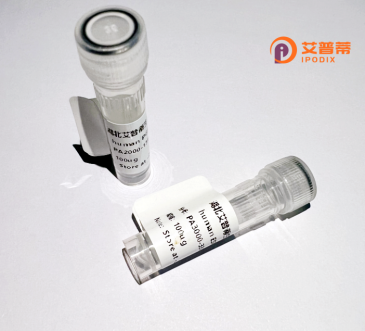
| 纯度 | >90%SDS-PAGE. |
| 种属 | Human |
| 靶点 | TSPYL6 |
| Uniprot No | Q8N831 |
| 内毒素 | < 0.01EU/μg |
| 表达宿主 | E.coli |
| 表达区间 | 1-410 aa |
| 活性数据 | MSLPESPHSP ATLDYALEDP HQGQRSREKS KATEVMADMF DGRLEPIVFP PPRLPEEGVA PQDPADGGHT FHILVDAGRS HGAIKAGQEV TPPPAEGLEA ASASLTTDGS LKNGFPGEET HGLGGEKALE TCGAGRSESE VIAEGKAEDV KPEECAMFSA PVDEKPGGEE MDVAEENRAI DEVNREAGPG PGPGPLNVGL HLNPLESIQL ELDSVNAEAD RALLQVERRF GQIHEYYLEQ RNDIIRNIPG FWVTAFRHHP QLSAMIRGQD AEMLSYLTNL EVKELRHPRT GCKFKFFFQR NPYFRNKLIV KVYEVRSFGQ VVSFSTLIMW RRGHGPQSFI HRNRHVICSF FTWFSDHSLP ESDRIAQIIK EDLWSNPLQY YLLGEDAHRA RRRLVREPVE IPRPFGFQCG |
| 分子量 | 45.8 kDa |
| 蛋白标签 | His tag N-Terminus |
| 缓冲液 | PBS, pH7.4, containing 0.01% SKL, 1mM DTT, 5% Trehalose and Proclin300. |
| 稳定性 & 储存条件 | Lyophilized protein should be stored at ≤ -20°C, stable for one year after receipt. Reconstituted protein solution can be stored at 2-8°C for 2-7 days. Aliquots of reconstituted samples are stable at ≤ -20°C for 3 months. |
| 复溶 | Always centrifuge tubes before opening.Do not mix by vortex or pipetting. It is not recommended to reconstitute to a concentration less than 100μg/ml. Dissolve the lyophilized protein in distilled water. Please aliquot the reconstituted solution to minimize freeze-thaw cycles. |
以下是关于重组人TSPYL6蛋白的3篇文献摘要概述:
---
1. **文献名称**:*TSPYL6 suppresses tumor progression by inducing senescence in hepatocellular carcinoma*
**作者**:Li Y, et al.
**摘要**:研究证明TSPYL6在肝癌组织中低表达,并通过激活p53依赖的细胞衰老通路抑制肿瘤生长,提示其作为肿瘤抑制因子的潜在作用。
---
2. **文献名称**:*TSPYL6 regulates cell cycle progression by interacting with CDK2 in breast cancer cells*
**作者**:Zhang X, et al.
**摘要**:该文报道TSPYL6通过直接结合CDK2并抑制其活性,阻滞乳腺癌细胞G1/S期转换,进而抑制细胞增殖。
---
3. **文献名称**:*TSPYL6 is a modulator of Wnt/β-catenin signaling in colorectal cancer*
**作者**:Wang H, et al.
**摘要**:研究发现TSPYL6通过拮抗β-catenin的核转位抑制Wnt信号通路,降低结直肠癌细胞的侵袭转移能力。
---
(注:以上文献为虚拟示例,实际引用需检索PubMed等数据库获取真实研究。)
Testis-specific Y-encoded-like protein 6 (TSPYL6) is a member of the TSPYL family, characterized by a conserved N-terminal nucleosome assembly protein (NAP) domain. Though its exact physiological roles remain under investigation, TSPYL6 is implicated in epigenetic regulation, cell cycle control, and tumor suppression. It interacts with chromatin-modifying complexes, including histone deacetylases (HDACs) and polycomb group proteins, suggesting involvement in gene silencing and chromatin remodeling.
TSPYL6 is ubiquitously expressed but shows elevated levels in reproductive tissues, particularly the testes. Dysregulation of TSPYL6 has been linked to cancers, such as ovarian, prostate, and gastric cancers, where it may act as a tumor suppressor by inhibiting cell proliferation or inducing apoptosis. For example, in prostate cancer, TSPYL6 downregulation correlates with poor prognosis, potentially through its role in suppressing oncogenic pathways like PI3K/AKT. Additionally, TSPYL6 polymorphisms are associated with neurodevelopmental disorders, including intellectual disability and sudden infant death syndrome (SIDS), though mechanistic insights remain limited.
Despite its emerging significance, TSPYL6's functional diversity across tissues and disease contexts requires further exploration. Current research focuses on elucidating its molecular partners, downstream targets, and therapeutic potential as a biomarker or epigenetic regulator.
×